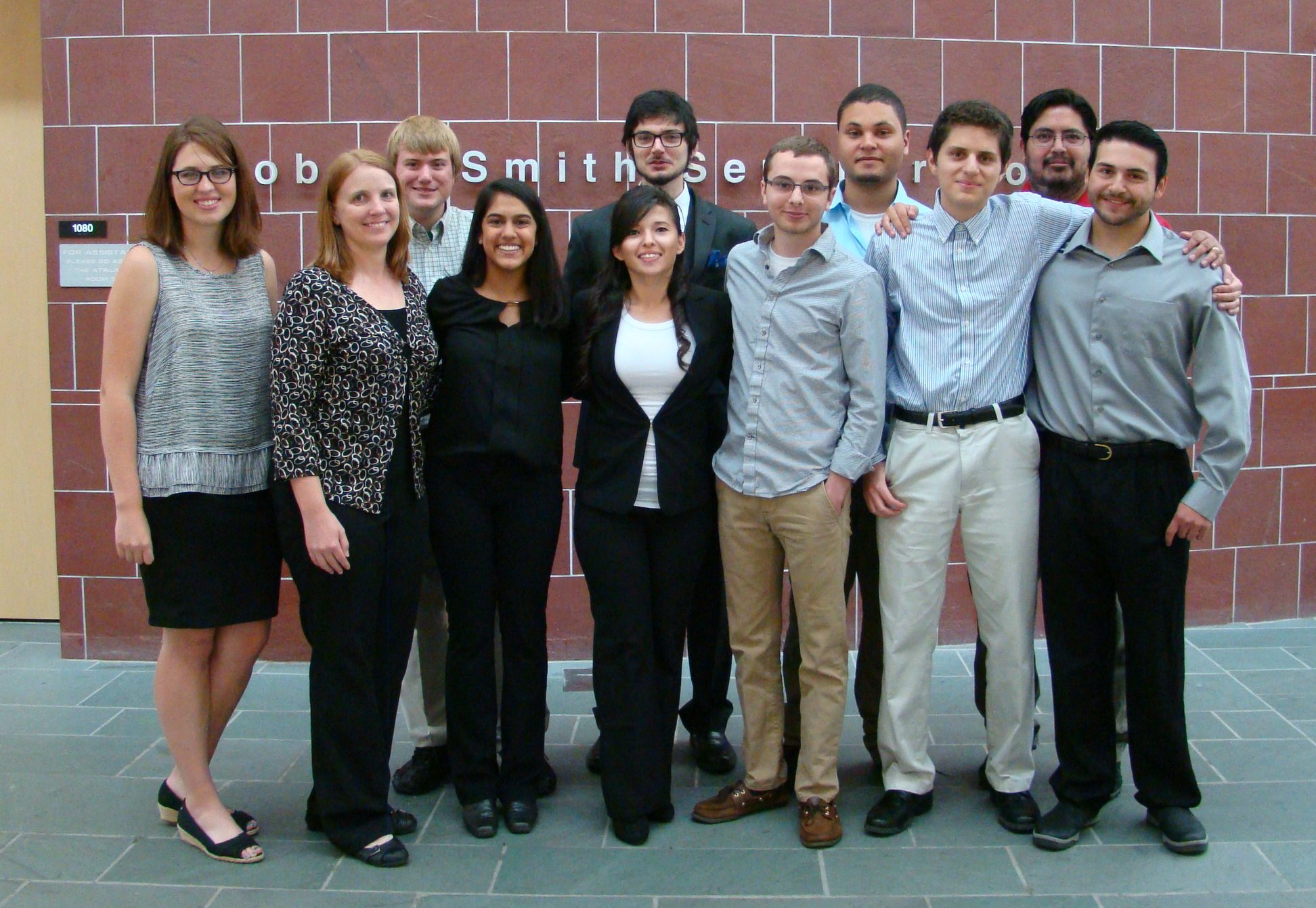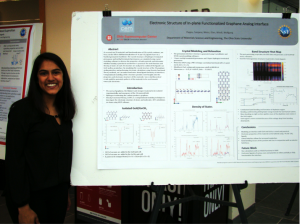Summer Research Experience for Undergraduates
Pages from CEM Research for Undergraduates Program Journal Part 1
Pages from CEM Research for Undergraduates Program Journal Part 2
Pages from CEM Research for Undergraduates Program Journal Part 3
2017 Summer REU Student Information & Research Abstracts
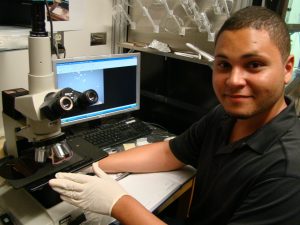
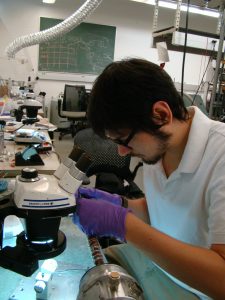 Name: Forrest Elliot
Name: Forrest Elliot
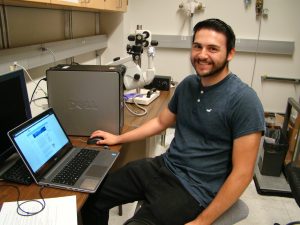 Name: Taylor Herrera
Undergraduate Institution: New Mexico Highlands University
Major: Computer Science
REU Advisors: Chris Hammel and Denis Pelekhov
Project Title: Magnetic field calculations of a micro-magnetic particle for the localized ferromagnetic resonance
Abstract:
We calculate magnetic fields emanating from a point dipole and create their maps in a 3-dimensional space. When a DC current flows through a bilayer system of ferromagnetic (FM) and normal metal (NM), the spin-orbit interaction on its interface causes the spin torque exerted on the FM. Above the certain threshold current, it can induce an auto-oscillation of a coherent magnetization precession, the same phenomenon observed in ferromagnetic resonance by applying a microwave field. We are interested in observing the auto-oscillation of FMR modes localized by a dipolar field generated from a micron-sized magnetic particle in the bilayer films consisting of the permalloy(Py, FM) and platinum(Pt, NM). In this project, the calculation of the magnetic field from a magnetic particle is essential for analyzing the data. Here we make a program that calculates a point dipole field and constructs its 3D map using a Python, assuming that our magnetic particle in a spherical shape has the same field from a point dipole with the same magnetic moment. The program is capable of imaging the magnitude and direction of the field in our assigned 3D space and the dipole in our calculation can be located at any position that we want.
Name: Taylor Herrera
Undergraduate Institution: New Mexico Highlands University
Major: Computer Science
REU Advisors: Chris Hammel and Denis Pelekhov
Project Title: Magnetic field calculations of a micro-magnetic particle for the localized ferromagnetic resonance
Abstract:
We calculate magnetic fields emanating from a point dipole and create their maps in a 3-dimensional space. When a DC current flows through a bilayer system of ferromagnetic (FM) and normal metal (NM), the spin-orbit interaction on its interface causes the spin torque exerted on the FM. Above the certain threshold current, it can induce an auto-oscillation of a coherent magnetization precession, the same phenomenon observed in ferromagnetic resonance by applying a microwave field. We are interested in observing the auto-oscillation of FMR modes localized by a dipolar field generated from a micron-sized magnetic particle in the bilayer films consisting of the permalloy(Py, FM) and platinum(Pt, NM). In this project, the calculation of the magnetic field from a magnetic particle is essential for analyzing the data. Here we make a program that calculates a point dipole field and constructs its 3D map using a Python, assuming that our magnetic particle in a spherical shape has the same field from a point dipole with the same magnetic moment. The program is capable of imaging the magnitude and direction of the field in our assigned 3D space and the dipole in our calculation can be located at any position that we want.
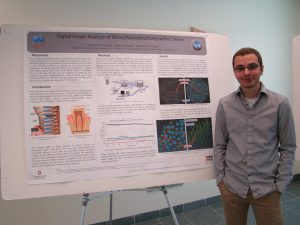 Name: Jimmy Kuznar
Undergraduate Institution: Columbus State Community College
Major: Chemical Engineering
REU Advisor: David McComb
Project Title: Digital image analysis of micro/nanostructures within dentin
Abstract:
There are three main layers to teeth. Enamel is the outermost layer followed by dentin and pulp. Dentin is produced by odontoblasts [1] which are cells located in the pulp of the tooth. Dentin is a composite material that mainly contains inorganic hydroxyapatite crystals (Ca5(PO4)3(OH)) and organic collagen matrix proteins [1]. Dentin contains microtubular structures that are present throughout at varying quantities and diameters [2]. Some of these microtubules have channel like structures that branch out from the tubules through the peritubular dentin and in some cases to other microtubules. These channel-like structures are referred to as ‘nanotubules’. This research seeks to better visualize the dentin tubules and peritubular dentin. How these micro and nano tubule features are positioned relative to each other can potentially provide significant insight into the diffusion of ionic species throughout the intertubular dentin in three-dimensional (3D) space.
Name: Jimmy Kuznar
Undergraduate Institution: Columbus State Community College
Major: Chemical Engineering
REU Advisor: David McComb
Project Title: Digital image analysis of micro/nanostructures within dentin
Abstract:
There are three main layers to teeth. Enamel is the outermost layer followed by dentin and pulp. Dentin is produced by odontoblasts [1] which are cells located in the pulp of the tooth. Dentin is a composite material that mainly contains inorganic hydroxyapatite crystals (Ca5(PO4)3(OH)) and organic collagen matrix proteins [1]. Dentin contains microtubular structures that are present throughout at varying quantities and diameters [2]. Some of these microtubules have channel like structures that branch out from the tubules through the peritubular dentin and in some cases to other microtubules. These channel-like structures are referred to as ‘nanotubules’. This research seeks to better visualize the dentin tubules and peritubular dentin. How these micro and nano tubule features are positioned relative to each other can potentially provide significant insight into the diffusion of ionic species throughout the intertubular dentin in three-dimensional (3D) space.
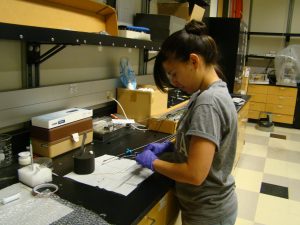 Name: Sindy Lauricella
Undergraduate Institution: New Mexico Highlands University
Major: Environmental Geology
REU Advisor: Ezekiel Johnston-Halperin
Project Title: Magnetic characterization of solvent resistance in vanadium tetracyanoethylene (V[TCNE]2)
Abstract:
Organic-based magnetic materials have beneficial applications such as electronic materials, room temperature magnetic ordering, and mechanical flexibility. The organic-based magnet we will be focusing on throughout this research is Vanadium tetracyanoethylene V[TCNE]x~2, a semiconducting ferrimagnet that displays room temperature magnetic ordering. It is considered a metal organic hybrid system because it’s combining an organic ligand with a metal atom. There are few projects that focus on different ways to analyze the limits of manipulating V[TCNE] one is replacing TCNE ligand with new ligands that are designed then adding dichloromethane to test weather the new ligands can make air-stable ferrimagnets. Another approach is adding solvents to metals and identify if there are any magnetic changes in the structure of V[TCNE]. This research will consist of synthesizing thin films of V[TCNE] with V(CO)6 and TCNE via Chemical Vapor Deposition (CVD) in a glass furnace. The grown CVD films decompose in air that result in loss of magnetic properties, which is why the process is done in an argon glove box. Once completed our V[TCNE] we will use the Superconducting Quantum Interference Device (SQUID) that helps identify the global magnetic ordering of the sample by measuring magnetization. SQUID will be used before adding a dichloromethane solvent to record the control measure of V[TCNE] and after the solvent is added. We are adding dichloromethane solvent to determine weather or not our V[TCNE] films are resistant to the solvent and see if there are changes in the magnetic field and in the microscopic scale. Electronic paramagnetic Resonance (EPR) will be used to identify what’s inside the material and see how much change has occurred in the signatures. Signatures are peaks shown in the data that we will later review to identify if the material continues to have V[TCNE] after adding the dichloromethane solvent.
Name: Sindy Lauricella
Undergraduate Institution: New Mexico Highlands University
Major: Environmental Geology
REU Advisor: Ezekiel Johnston-Halperin
Project Title: Magnetic characterization of solvent resistance in vanadium tetracyanoethylene (V[TCNE]2)
Abstract:
Organic-based magnetic materials have beneficial applications such as electronic materials, room temperature magnetic ordering, and mechanical flexibility. The organic-based magnet we will be focusing on throughout this research is Vanadium tetracyanoethylene V[TCNE]x~2, a semiconducting ferrimagnet that displays room temperature magnetic ordering. It is considered a metal organic hybrid system because it’s combining an organic ligand with a metal atom. There are few projects that focus on different ways to analyze the limits of manipulating V[TCNE] one is replacing TCNE ligand with new ligands that are designed then adding dichloromethane to test weather the new ligands can make air-stable ferrimagnets. Another approach is adding solvents to metals and identify if there are any magnetic changes in the structure of V[TCNE]. This research will consist of synthesizing thin films of V[TCNE] with V(CO)6 and TCNE via Chemical Vapor Deposition (CVD) in a glass furnace. The grown CVD films decompose in air that result in loss of magnetic properties, which is why the process is done in an argon glove box. Once completed our V[TCNE] we will use the Superconducting Quantum Interference Device (SQUID) that helps identify the global magnetic ordering of the sample by measuring magnetization. SQUID will be used before adding a dichloromethane solvent to record the control measure of V[TCNE] and after the solvent is added. We are adding dichloromethane solvent to determine weather or not our V[TCNE] films are resistant to the solvent and see if there are changes in the magnetic field and in the microscopic scale. Electronic paramagnetic Resonance (EPR) will be used to identify what’s inside the material and see how much change has occurred in the signatures. Signatures are peaks shown in the data that we will later review to identify if the material continues to have V[TCNE] after adding the dichloromethane solvent.
 Name: Andrew Lininger
Undergraduate Institution: University of Akron
Major: Physics
REU Advisor: Jay Gupta
Project Title: Thin-film Cu2O growth and surface structure on Cu(100): An STM study
Abstract:
The growth and surface structure of thin-film Cu2O on a crystalline Cu (100) surface has been studied through low temperature ultra-high vacuum scanning tunneling microscopy (UHV-STM). Two distinct regions are observed on the surface: adlayer terraces, exhibiting characteristic step edges of 4Å, and flat patches with a distinctive striped pattern. The adlayer is identified as oxidation of the Cu (100) surface through atomic resolution of the ‘ladder’ structure (missing-row reconstruction), with rectangular depressions on 3.7Å. The surface is observed under cold in situ dosing of CO2. The flat striped patches are associated with the Cu2O (111) surface, identified by two distinct patterns of protrusions: a (1×1) periodicity hexagonal lattice with spacing 3.1Å and an atomically resolved (√3x√3)R30° periodicity lattice with spacing of 5.2Å. The first structure is attributed to individual copper ions on the stoichiometric ideal (111) surface and the second to oxygen vacancies and the nearest-neighbor Cu atoms on the same surface. This demonstrates that similar structures occur on monolayer Cu2O (111) as on the bulk Cu2O (111) surface.
Name: Andrew Lininger
Undergraduate Institution: University of Akron
Major: Physics
REU Advisor: Jay Gupta
Project Title: Thin-film Cu2O growth and surface structure on Cu(100): An STM study
Abstract:
The growth and surface structure of thin-film Cu2O on a crystalline Cu (100) surface has been studied through low temperature ultra-high vacuum scanning tunneling microscopy (UHV-STM). Two distinct regions are observed on the surface: adlayer terraces, exhibiting characteristic step edges of 4Å, and flat patches with a distinctive striped pattern. The adlayer is identified as oxidation of the Cu (100) surface through atomic resolution of the ‘ladder’ structure (missing-row reconstruction), with rectangular depressions on 3.7Å. The surface is observed under cold in situ dosing of CO2. The flat striped patches are associated with the Cu2O (111) surface, identified by two distinct patterns of protrusions: a (1×1) periodicity hexagonal lattice with spacing 3.1Å and an atomically resolved (√3x√3)R30° periodicity lattice with spacing of 5.2Å. The first structure is attributed to individual copper ions on the stoichiometric ideal (111) surface and the second to oxygen vacancies and the nearest-neighbor Cu atoms on the same surface. This demonstrates that similar structures occur on monolayer Cu2O (111) as on the bulk Cu2O (111) surface.
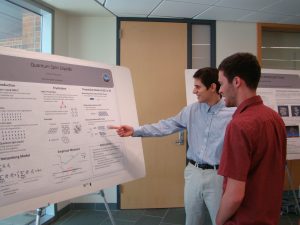 Name: Omar Mansour
Undergraduate Institution: The Ohio State University
Major: Physics and Electrical Engineering
REU Advisor: Nandini Trivedi
Project Title: Quantum spin liquids
Abstract:
Name: Omar Mansour
Undergraduate Institution: The Ohio State University
Major: Physics and Electrical Engineering
REU Advisor: Nandini Trivedi
Project Title: Quantum spin liquids
Abstract:
One of the topics examined this summer was quantum spin liquids. In low temperature systems, there are two competing effects that influence magnetic order: classical ordering and quantum fluctuations. In antiferromagnetic materials, this “battle” between quantum and classical effects is usually won by antiferromagnetic interactions, resulting in a Néel ordered state at low temperatures. However, in certain materials, the quantum paramagnetic phase persists all the way to zero temperature, forming an exotic state of matter called a quantum spin liquid (QSL).
Name: Sanjana Pappu Undergraduate Institution: University of Texas, Austin Major: Chemical Engineering REU Advisor: Wolfgang Windl Project Title: Electronic structure of in-plane functionalized graphane analog interface Abstract: As research on 2D materials and functionalization of 2D crystals continues, we focus on the effects full functionalization of -H and -CH3 ligands have on a buckled germanene backbone. The crystal structures of hydrogen-terminated germanene and methyl-terminated germanene are simulated using crystal modeling software to observe the properties of both materials and determine whether forming a junction in an interface is practical. The work function and density of states of each 2D structure are analyzed to confirm if the ligands can work well in an interface. By simulating the crystal structure of 2D graphane analog interface and performing electronic calculations using Density Functional Theory methods, we can understand more about ligand chemistry on interfaces. Computational modeling of the structures provides novel insights into the properties and electronic structures of the materials. Successful theoretical results yield for potential synthesis of the materials to be used in the future for devices.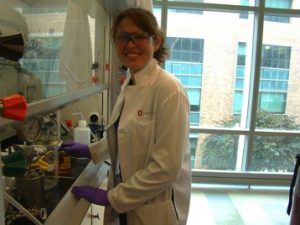 Name: Erin Snyder
Undergraduate Institution: Rollins College
Major: Chemistry
REU Advisor: Joshua Goldberger
Project Title: Materials with anisotropic Seebeck behavior for transverse thermoelectrics
Abstract:
Alternative energy sources are becoming more desirable to replace other sources that have significant environmental effects or lose a large fraction of the generated energy as waste heat. One solution to this problem is a thermoelectric device, which creates a current from a change in voltage produced by a heat gradient. Typical thermoelectric devices require two separate materials containing different majority carrier types, both p-type and n-type. This allows holes and electrons to travel from the hot end to the cold end, respectively, thereby creating a difference in electrical potential. If one material were able to possess both p-type and n-type behavior in perpendicular axes, as seen through an anisotropic Seebeck coefficient, these devices would offer more practical device engineering as well as geometric adaptability. Several possible candidates were identified by their band structure indicating both p-type and n-type character, including CaAgBi, CaAgSb, CaCuBi, and CaCuSb, and formed using inorganic chemistry crystal synthesis. Phase-pure samples were synthesized by reacting stoichiometric amounts at high temperatures followed by slow cooling and were characterized by X-Ray Diffraction and Raman Spectroscopy. The next step towards transverse thermoelectric devices is creating large, single crystals to find axis dependence in Seebeck coefficients.
Name: Erin Snyder
Undergraduate Institution: Rollins College
Major: Chemistry
REU Advisor: Joshua Goldberger
Project Title: Materials with anisotropic Seebeck behavior for transverse thermoelectrics
Abstract:
Alternative energy sources are becoming more desirable to replace other sources that have significant environmental effects or lose a large fraction of the generated energy as waste heat. One solution to this problem is a thermoelectric device, which creates a current from a change in voltage produced by a heat gradient. Typical thermoelectric devices require two separate materials containing different majority carrier types, both p-type and n-type. This allows holes and electrons to travel from the hot end to the cold end, respectively, thereby creating a difference in electrical potential. If one material were able to possess both p-type and n-type behavior in perpendicular axes, as seen through an anisotropic Seebeck coefficient, these devices would offer more practical device engineering as well as geometric adaptability. Several possible candidates were identified by their band structure indicating both p-type and n-type character, including CaAgBi, CaAgSb, CaCuBi, and CaCuSb, and formed using inorganic chemistry crystal synthesis. Phase-pure samples were synthesized by reacting stoichiometric amounts at high temperatures followed by slow cooling and were characterized by X-Ray Diffraction and Raman Spectroscopy. The next step towards transverse thermoelectric devices is creating large, single crystals to find axis dependence in Seebeck coefficients.

